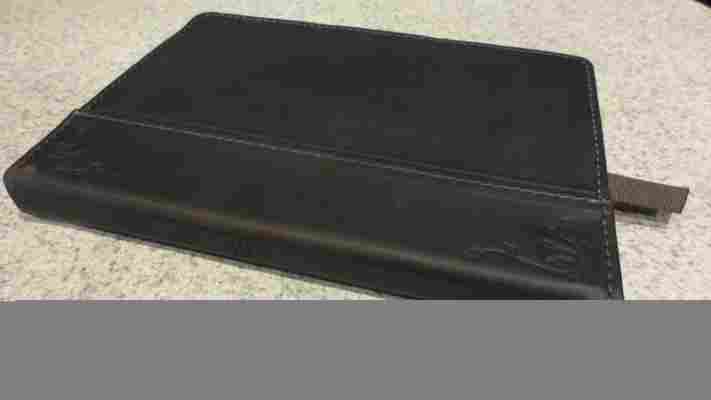As much of a slim and sexy factor as my new iPad Mini has, toting around a $500 device without some form of protection just doesn’t seem like a smart idea. While I’m careful myself, I have two kids, a hyperactive dog and an accident-prone wife. While there is no shortage of great cases available, Pad & Quill’s Aria for iPad Mini is an $89 masterpiece of craftsmanship, so it’s time for our review.

You’d be forgiven for quickly making the comparison between the Aria and the BookBook from perennial TNW favorite Twelve South . The leather-bound, book-inspired design brings both cases in parity with one another. Further, Twelve South has made quite the name for itself via exquisite craftsmanship as well. But generalities aside, the specifics of the Aria most definitely differentiate it from the competitors.
Opening the Aria, you’ll notice that your iPad sits inside of a custom wooden frame. The corners of this frame contain small pieces of a rubber-like material, which serve to hold your device in place. While I’m a fan of the fully-enclosed interior of the BookBook, the Aria’s design works well and I’ve never felt as if my device was in any danger of falling.
The Aria, like all of Pad & Quill’s iPad cases. has a bookmark-esque piece of ribbon which runs under your device, allowing you the leverage that you’ll need in order to remove it from the case. Doing so is no easy task, and will likely wear down the rubberized inserts, but there are replacements included with the case.
The Aria is the only one of PQ’s iPad Mini cases that offers a dedicated method for creating a stand. Akin to many others on the market, a tab on the back lifts slightly, allowing you to insert the folded-over front cover. I’m slightly concerned that, after years of use, this tab may find itself permanently raised from the surface of the case, but the leather is dense enough that it shouldn’t be an issue for quite some time to come.
That same density of materials also means that, for the first few weeks, you’ll be in a break-in period with your Aria case. Folding the cover back onto itself, for instance, will not make it sit completely flush with the back until the leather has had some time to soften. The same can be said for setting up the Aria in its triangular-stand shape. The leather, especially on the binding, will take some wear time before it will sit perfectly.
That’s not to say that I’ve been unable to use the case in its intended fashion. I simply took a couple of minutes to manipulate the leather before notching the front cover into the rear slot and my iPad stood just fine. While it did not sit flush, I have no doubt that it will after some weeks of use. It’s a small trade-off to accept, given that we’re talking about a case that will likely be around for a lot longer than your iPad.
As you can see in the pictures, while most of the notches for the case are cut out exactly where they’re needed, the one for the power button doesn’t line up perfectly. While understandable (as doing so would have meant less protection for the corner of the case) it’s still a bit odd. Fortunately, because the Aria supports sleep and wake functions with the closing and opening of the cover, there’s no cause for concern.
Despite the rather large, wooden frame, the Aria still manages to stay lightweight. In fact, its overall size is slightly smaller than that of the BookBook; a surprising fact when you consider the framing and thickness of the leather in which it is bound.
If I had to name any gripes about the Aria, (and believe me, I’m stretching here) it would be in two design choices. An elastic band holds the Aria’s cover closed, and I worry that over time it might lose its spring. I’ve seen this happen with journals and other styles of books after a couple of years of use, so it’s natural to think that it’s possible with the Aria.
My second concern, though it’s honestly just more of a comparison, is that I believe the BookBook is probably the more protective of the two cases. Given the full, internal sleeve of the BookBook, plus the zipper to hold everything in place, it feels like it’s offering more insurance than the Aria. That’s not to say that the Aria isn’t protective, but again it’s just a comparison between two cases that will likely go head-to-head in a buying decision.
There’s no denying the quality of Pad & Quill cases. Everything in the iPad Mini line is done with the utmost of care and attention to detail and the Aria is no exception. Simply sliding your iPad into place, then looking at it from the side view will show you how much time and exacting measurements have gone into the manufacturing of these beautiful, protective covers.
With a cost of $89, the Aria is priced in line with other ultra-premium cases. If you want a slightly less pricey option, you can opt for the screen-printed Graduate case, or the book-styled Octavo case. Either of these will save you $20. A drop down to $59 gets you the cloth-covered, hardbound Graduate case. Whichever you choose, the same attention to detail is still present. But if luxury is what you’re searching for, then the Aria should be at the top of your case-buying list.
Here’s what the new Google Glass apps from Foursquare, TripIt, OpenTable are like to use
With this week’s announcement that the Google Glass is officially on sale for anyone in the US with $1,500 sitting pretty , it’s no surprise that the company launched more general consumer apps to accommodate more lifestyle products. We went hands on with three new Glassware apps – Foursquare, TripIt and OpenTable – as well as updates to Google Search/Now/Maps, Word Lens and Field Trip. Here are some initial thoughts.

As with all Glass commands, to get the device to listen to you, you’ll have to start with the “Ok Glass” prompt. The Foursquare app allows you to say “Check me in” or “Find a place” and the app will target results based on your GPS location.
If you choose to check in, the Glass will display locations based on your profile’s check-in history or places your friends have been. You can scroll through the results using the right touch panel and tap to check in. Unfortunately, the app does not allow you to name a place you want to check in to, so you’ll have to hope the GPS has you in the most accurate spot to find what you’re looking for.
The explore command also works the same way as the check in. Simply say a keyword, such as “wine bar” or “free Wi-Fi” and Glass will use Foursquare’s API to hunt results that match your query.
Unlike Foursquare, the OpenTable Glassware is less tied to your current location. The command “Make a reservation” will allow you to specifically name a restaurant of choice, or say the city you’re looking to dine in, before displaying results.
Again, the Glass command here stops at your audio search query. You still have to manually swipe to browse through results, and once you’ve found what you’re looking for, you can tap and scroll forward to select date, time, and number of people in your party. At the moment, once you’ve made your reservation, you cannot adjust it through the Glassware.
The TripIt Glassware is the only app that does not have a specific audio command. Rather, if you swipe to the left, the Glass screen will display the current or upcoming itinerary. This is designed so you can quickly glance at your schedule to check if you are on time.
You can also look up or down to see earlier and later parts of your itinerary (for example: look up to see a 7 a reservation for a car pickup, look down to see the 10 a flight schedule). Tapping on the current section of the itinerary can also bring up additional commands, such as directions to the airport.
Admittedly, looking up to see previous itinerary items felt highly unnatural to do, especially when you’re looking on from a third person point of view. If other Glassware apps are scroll-activated, why have this one force you to look around like a madman?
Unfortunately, the TripIt Glassware will also not send push notifications to the Glass if your trip is interrupted. You’ll have to check your phone for any alerts… or accidentally swipe left at the opportune time to see changes to your itinerary.
Out of all the Glassware apps, Word Lens seems like the most helpful app in terms of travel. The command “Translate this” lets you look at a sign in a foreign language and the app will translate the image right before your eyes. At the moment, the app can only translate a handful of languages, including Russian and Spanish, and you still need to scroll through the list of available languages to find the one you want (English to Portuguese vs. Portuguese to English) but developers say they plan to add a voice prompt to lessen the search time.
Though the Word Lens app works quite well, it’s the Glass hardware itself that limits the app’s abilities. Since the Glass’ camera isn’t great at focusing on macro images, it will be hard to translate things in smaller fonts. I tried translating a brochure and it was unable to read the text on the paper, so at the moment, the app is best left for signs and posters.
These functionalities are pretty self-explanatory. You can ask Google to search for something like you would to your Android phone or tablet, and Google will read back the results to you (“How do you say ‘That’s awesome’ in Dutch?” for example).
“Get directions to” also opens up the Maps functionality, allowing you to scroll forward and back to find the mode of transportation you want (driving, public transportation, walking, biking). The Glass uses your GPS location to give you turn-by-turn location, so even if you turn your head to the left, it will know which direction you’re facing according to the map. This is helpful for when you want to check if you’re headed in the right direction in a foreign city.
Similar to Foursquare, the Glass update on Field Trip lets you discover your local neighborhood with the command “Explore nearby.” Field Trip will use your GPS location to offer several results, including lengthy descriptions (which you can have the Glass read aloud to you) and photos. It’s basically Foursquare search on steroids.
With their launch today, these Glassware apps have quite a way to go to convince Glass users to convert to using them versus the versions on a smartphone. The lack of verbal commands after the first prompt makes them less seamless than one would prefer.
Travel is a smart vertical for Google to tackle as it makes Glass functional in more real-world use cases. Word Lens and Google Maps are good examples of apps that will likely get the most mileage; however, keep in mind that open beta means Glass and its respective apps are still under development and it will be some time before you can travel handsfree without ever looking down at your phone, or tapping the side of your temple.
